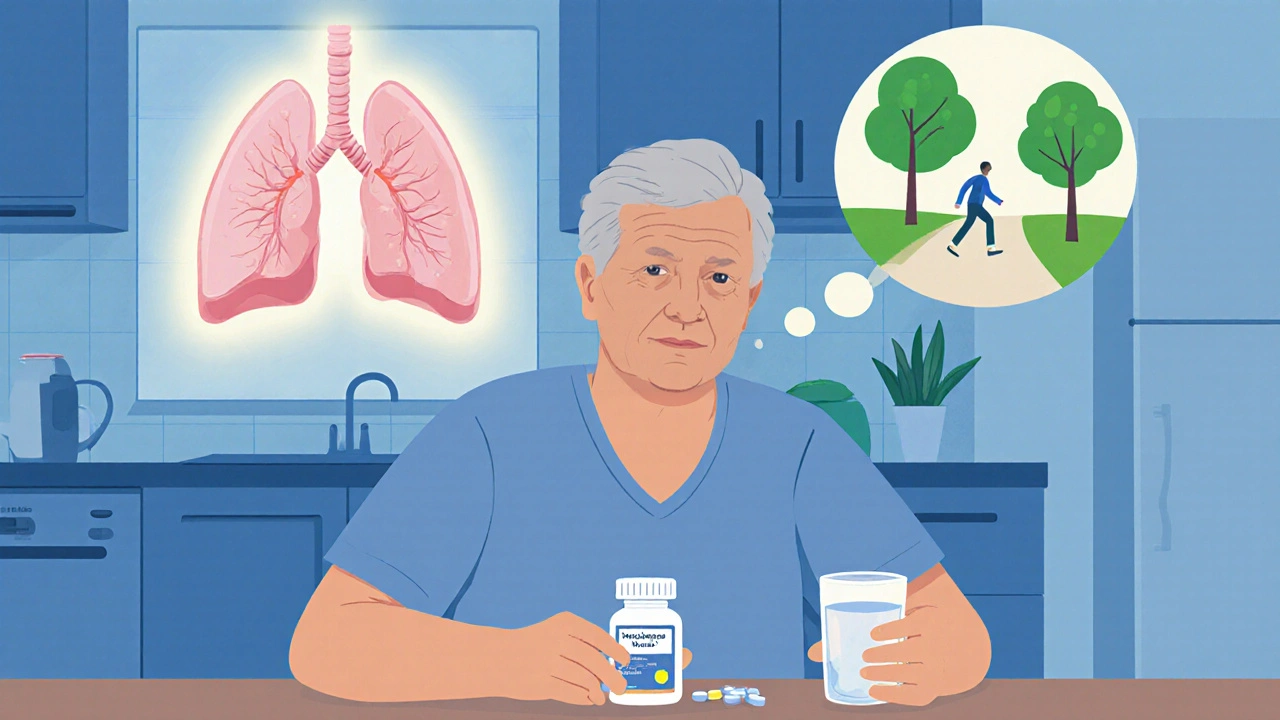Idiopathic Pulmonary Fibrosis
When dealing with idiopathic pulmonary fibrosis, a chronic, progressive scarring of lung tissue with no known cause. Also known as IPF, it reduces breathing capacity and quality of life, clinicians often turn to anti‑fibrotic medication, drugs such as nintedanib or pirfenidone that slow tissue scarring. Regular pulmonary function testing, spirometry and diffusion capacity measurements that track lung performance over time provides the data needed to adjust therapy, while lung transplantation, a surgical option for end‑stage disease offering potential long‑term survival remains the last resort. For symptom relief, many patients use aerosol drugs, inhaled bronchodilators or corticosteroids delivered by nebulizer to ease short‑term breathlessness. Below you’ll find practical guides that walk through diagnosis, treatment choices, monitoring tools, and lifestyle tips.
IPF typically presents with a dry cough and worsening shortness of breath, especially during exertion. High‑resolution CT scans reveal a characteristic honey‑comb pattern that helps differentiate IPF from other interstitial lung diseases. Early detection matters because once fibrosis is established, lung tissue cannot regenerate, and the disease trajectory accelerates. Recognizing subtle symptom changes early can prompt timely therapeutic interventions.
Treatment Options Overview
The backbone of IPF management lies in anti‑fibrotic medication. Nintedanib inhibits multiple tyrosine kinases involved in fibroblast activation, while pirfenidone modulates oxidative stress and cytokine production. Both drugs have been shown in clinical trials to reduce the rate of forced vital capacity (FVC) decline. However, they come with side effects—diarrhea, nausea, and liver enzyme elevations—that require regular lab monitoring and dose adjustments.
Monitoring lung function is essential for gauging disease progression and treatment response. Spirometry provides FVC, a key metric, while the diffusing capacity for carbon monoxide (DLCO) reflects gas exchange efficiency. A drop of more than 10% in FVC over six months often signals accelerating fibrosis and may trigger a reassessment of therapy or transplant evaluation.
When anti‑fibrotic drugs no longer preserve lung function, lung transplantation becomes a viable option. Candidates typically have an FVC below 30% of predicted, severe hypoxemia, or rapid disease progression despite optimal medical therapy. Single‑lung transplants are common for IPF, offering comparable outcomes to double‑lung procedures with a shorter recovery period. Post‑transplant, patients require lifelong immunosuppression and regular follow‑up.
Inhaled aerosol therapies are not disease‑modifying but provide symptomatic relief. Short‑acting bronchodilators can open airway passages during flare‑ups, while inhaled corticosteroids may reduce inflammation in patients with overlapping COPD features. Proper inhaler technique and device selection (metered‑dose inhaler vs. nebulizer) affect drug delivery efficiency and should be reviewed during each clinic visit.
Beyond medication, lifestyle adjustments play a big role in maintaining daily function. Supplemental oxygen improves exercise tolerance and reduces dyspnea, especially during nighttime. Pulmonary rehabilitation programs combine exercise training, education, and breathing techniques, often leading to measurable improvements in six‑minute walk distance. Smoking cessation is mandatory; even past exposure accelerates fibrotic changes.
Research into IPF is rapidly evolving. Ongoing clinical trials explore novel agents targeting connective tissue growth factor, lysyl oxidase‑like 2, and the integrin pathway. Biomarkers such as serum matrix metalloproteinase‑7 (MMP‑7) and peripheral blood mononuclear cell gene signatures aim to predict disease course and personalize therapy. Genetic studies highlight telomerase mutations in a subset of patients, opening the door for future gene‑based interventions.
Ready to dive deeper? Below you’ll discover step‑by‑step guides covering everything from diagnosis to advanced therapies. idiopathic pulmonary fibrosis patients and caregivers will find actionable insights, medication overviews, monitoring tips, and the latest research updates—all curated to help you make informed decisions.





